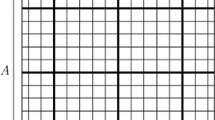Abstract
This paper develops a simple analytical model for determining the hierarchical system of road networks. The model is based on a grid road network where roads are classified into three types according to road widths and travel speeds. We derive the optimal ratios of road areas that minimize the average and maximum travel time. Minimizing the average travel time provides an efficient solution, whereas minimizing the maximum travel time provides an equitable solution. Both of the solutions are expressed in terms of road widths and travel speeds. As an application of the grid network model, we evaluate the hierarchical system of the road network of Tokyo.
Similar content being viewed by others
References
Aldaihani, M. M., Quadrifoglio, L., Dessouky, M. M., & Hall, R. (2004). Network design for a grid hybrid transit service. Transportation Research A, 38, 511–530.
Balakrishnan, A., Magnanti, T. L., & Mirchandani, P. (1994a). A dual-based algorithm for multi-level network design. Management Science, 40(5), 567–581.
Balakrishnan, A., Magnanti, T. L., & Mirchandani, P. (1994b). Modeling and heuristic worst-case performance analysis of the two-level network design problem. Management Science, 40(7), 846–867.
Bell, M. G. H., & Iida, Y. (1997). Transportation network analysis. Chichester: Wiley.
Buchanan, C. (1963). Traffic in towns: a study of the long-term problems of traffic in urban areas. London: HMSO.
Campbell, J. F. (1992a). Location and allocation for distribution systems with transshipments and transportation economies of scale. Annals of Operations Research, 40, 77–99.
Campbell, J. F. (1992b). Selecting routes to minimize urban travel time. Transportation Research B, 26, 261–274.
Chopra, S., & Tsai, C. Y. (2002). A branch-and-cut approach for minimum cost multi-level network design. Discrete Mathematics, 242, 65–92.
Creighton, R. L., Hoch, I., Schneider, M., & Joseph, H. (1960). Estimating efficient spacing for arterials and expressways. Highway Research Board Bulletin, 253, 1–43. National Research Council.
Current, J. (1988). The design of a hierarchical transportation network with transshipment facilities. Transportation Science, 22, 270–277.
Current, J. R., Revelle, C. S., & Cohon, J. L. (1986). The hierarchical network design problem. European Journal of Operational Research, 27, 57–66.
Fairthorne, D. (1963). The distances between pairs of points in towns of simple geometrical shapes. In Proceedings of the second international symposium on the theory of road traffic flow (pp. 391–406).
Fawaz, M. Y., & Newel, G. F. (1976a). Optimal spacings for a rectangular grid transportation network—I. Transportation Research, 10, 111–119.
Fawaz, M. Y., & Newel, G. F. (1976b). Optimal spacings for a rectangular grid transportation network—II. Transportation Research, 10, 121–129.
Hall, R. W. (1984). Travel distance through transportation terminals on a rectangular grid. Journal of Operations Research Society, 35(12), 1067–1078.
Langevin, A., Mbaraga, P., & Campbell, J. F. (1996). Continuous approximation models in freight distribution: an overview. Transportation Research B, 30, 163–188.
Oyama, T., & Taguchi, A. (1996). Application of the shortest path counting problem to evaluate the importance of city road segments in Japan. In Y. Matsuda & M. Fushimi (Eds.), Perspectives of advanced technology society 3: urban life and traffic (Vol. 3, pp. 3–19). Tokyo: Maruzen Planet Co.
Taaffe, E. J., Gauthier, H. L., & O’Kelly, M. E. (1996). Geography of transportation. Upper Saddle River: Prentice Hall.
Tanner, J. C. (1968). A theoretical model for the design of a motorway system. Transportation Research, 2, 123–141.
Vaughan, R. J. (1987). Urban spatial traffic patterns. London: Pion.
Author information
Authors and Affiliations
Corresponding author
Rights and permissions
About this article
Cite this article
Miyagawa, M. Optimal hierarchical system of a grid road network. Ann Oper Res 172, 349–361 (2009). https://doi.org/10.1007/s10479-009-0630-4
Published:
Issue Date:
DOI: https://doi.org/10.1007/s10479-009-0630-4




